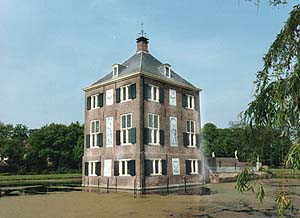|
Jacob van Eyck Quarterly |
2004, No. 1 (January) |
|||
|
Music for the Janskerkhof (2): 'Wat zalmen op den Avond doen'
Apart
from 'De lustelycke Mey', Der Fluyten Lust-hof contains two
more pieces which can be linked to the Utrecht Janskerkhof: both sets
of variations on 'Wat zalmen op den Avond doen' ('What shall we do
in the evening?') [NVE 51 & 52]. In the original sources, the
first set has five variations (Modo 2-6), the second one has even
eight (Modo 2-9). Both works start with an unadorned theme, in different
versions. In the first, the second strain is fluent, lyrical and a
little melancholic. In the second set, it is more surly. [music
example]
|
||||
|
Was wölln
wir auf den Abend thun? |
What shall
we do in the evening? (Translation: Ruth van Baak-Griffioen) |
|||
|
|
||||
|
Constantijn Huygens, the poet, statesman, composer and musician who was a distant relative of Van Eyck and to whom Der Fluyten Lust-hof was dedicated, describes in a long ode to his country estate Hofwijck near The Hague, how 'Wat sal men op den Avond doen' was sung when the guests went home at the end of the day, all accompanied by 'many thank-you's' (Hofwijck, lines 2161-2164). |
 |
|||
|
One can easily imagine that the melody and its variations were used in a similar context on the Utrecht Janskerkhof, at the close of Van Eyck's outdoor performances. If this was common practice, it could explain why there are two different sets, on two different versions of the same theme, for variety's sake. The second set especially has the character of a rousing last number. The piece is unequalled in its abundance of variations. First, Van Eyck starts breaking notes until 32nds appear. Then, he changes to triple time, building up a new variation sequence. People strolling in the churchyard may have understood that it was time to say goodbye when Van Eyck started one of these two pieces. The second set is even bigger than the original sources suggest. Evidence exists that Modo 5 of the first set actually belongs to the second one, where it should become Modo 4 (turning what is 'Modo 4 en 5' into Modo 5); this variation clearly follows the version of the theme as given in the second set. [example] Modern performers are inclined to play the pieces too fast. The variation dominated by 32nds limits the tempo. The tune is an 'Allemande', described by Johann Gottfried Walther (1708) as 'a little German song or dance, that is not performed too agile and quick, but a little moody and slow.' References |
||||
| Thiemo Wind | ||||
|
No. 2004/2 will be available on 1 April, 2004 Interested in receiving a reminder? Send an e-mail: Did you reach this page through a search engine? Click below to go to the |
||||